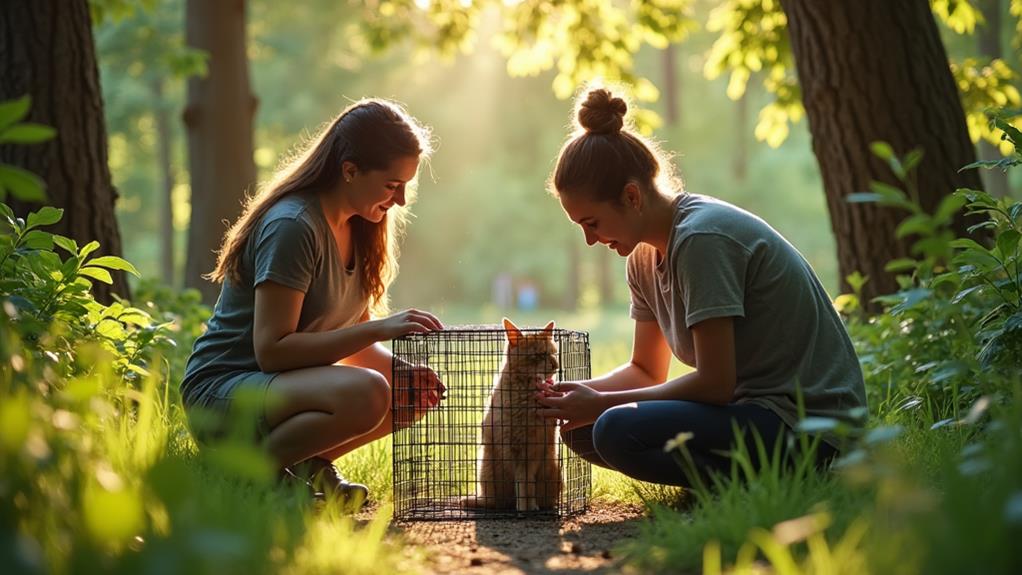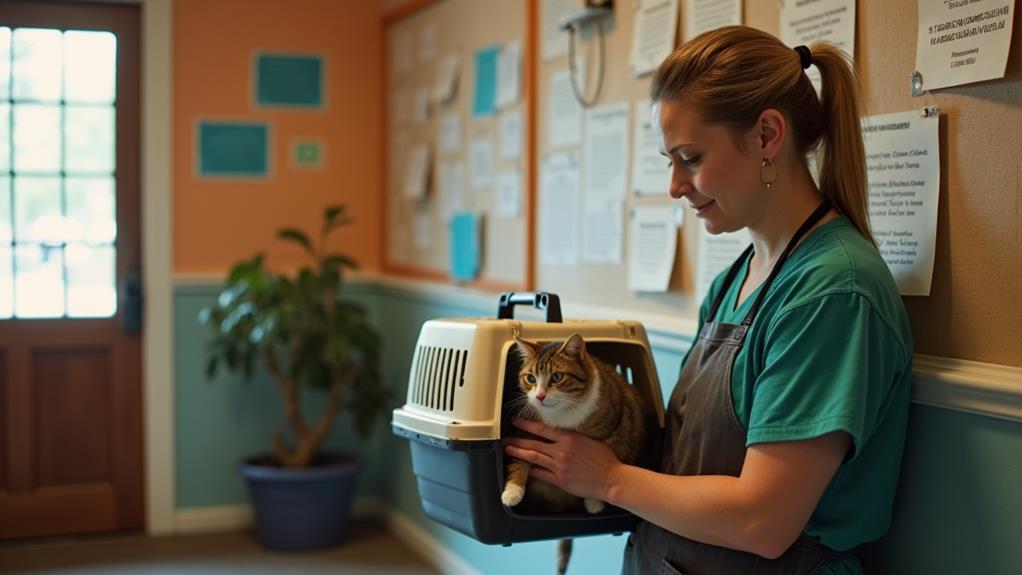Where Can I Take a Feral Cat? Resources for Rehoming or Sheltering

If you're looking to rehome or shelter a feral cat, start with local Trap-Neuter-Return (TNR) programs like the Feral Cat Assistance Program. They offer free spay/neuter surgeries, vaccinations, and humane trap rentals. Local shelters and clinics, such as the Houston Humane Society, also provide essential services for feral cat care. Friendly stray cats may find homes through rescue groups specializing in feral adoptions. Consider safe relocation strategies if needed, ensuring ample food, water, and shelter at their new location. For those seeking more options or information on supporting feral cats, further details are readily accessible.
Understanding Feral Cats
Feral cats, also known as community cats, are those elusive felines you might spot darting through alleyways or lounging in sunlit patches outdoors. These cats live independently of humans and often display wary, fearful behavior. While some feral cats are born in the wild, others might have been lost or abandoned pets. Despite their independent nature, feral cats can thrive by relying on natural resources or through human feeding.
Understanding feral cats involves recognizing their unique lifestyle and needs. They're not typical pets and often resist human interaction. It's vital to know that a Trap-Neuter-Return (TNR) program is the most humane way to manage and support these cat populations. The TNR program involves safely trapping feral cats, having them neutered or spayed, and then returning them to their original environment. This approach helps prevent overpopulation and maintains healthier community cat colonies.
If you encounter feral kittens, keep in mind that socialization is most effective when they're between 6-10 weeks old. Beyond this period, it becomes challenging to adapt them to human contact. Understanding these aspects can help you contribute positively to managing and supporting feral cat communities.
TNR Program Benefits
Recognizing the complexities of feral cats' lifestyles helps underscore the significance of effective management strategies like the Trap-Neuter-Return (TNR) program. By participating in a feral cat program, you contribute to reducing the population effectively. TNR works by sterilizing and returning cats to their original locations, which prevents further reproduction and stabilizes colonies. This method not only controls numbers but also improves the general health of community cats. You'll notice a reduction in fighting and stress-related behaviors, making the population more manageable.
A significant benefit of TNR is the positive impact on local shelters. With healthier, non-reproducing cats, intake and euthanasia rates decrease. As a result, shelters aren't overwhelmed, and cats are less likely to be viewed as problematic. Additionally, community education plays a crucial role in the success of TNR initiatives. By promoting understanding of feral cats' roles in local ecosystems, residents can coexist more harmoniously with these feline neighbors.
TNR is a more humane and effective method for controlling feral cat populations compared to euthanasia. It avoids the vacuum effect, where new cats quickly replace those removed, ensuring a sustainable and compassionate approach to feral cat management.
Finding TNR Resources

Participating in the Trap-Neuter-Return (TNR) program becomes much easier when you know where to find the right resources. Start by connecting with organizations like the Feral Cat Assistance Program (FCAP), which can greatly aid your efforts. FCAP not only offers free spay/neuter surgeries for feral cats but also provides necessary vaccinations, ensuring the cats are healthy when returned to their original locations. This approach helps control the feral cat population humanely and effectively.
To kick off your TNR activities, you can access humane traps from FCAP at no charge. They offer a 10-day rental period, allowing you ample time to trap and transport the cats to participating clinics. Local clinics such as the Houston Humane Society and Citizens for Animal Protection are essential players in the TNR scene, providing sterilization services that are critical for managing the feral cat population.
Consider the Fix Houston Initiative as a model of success; they've completed over 5,500 surgeries, preventing more than 110,000 potential births. By utilizing these resources, you play an important role in controlling feral cat populations, ensuring fewer cats face the challenges of life in the wild.
Feral Cat Assistance Programs
After tapping into TNR resources, it's time to investigate how feral cat assistance programs can bolster your efforts. The Feral Cat Assistance Program (FCAP) is a significant ally in managing feral cat populations through Trap-Neuter-Return. They provide fundamental services, ensuring feral cats receive the care they need while supporting your efforts to maintain healthy feral cat colonies.
Here's how FCAP can help you:
- Free Veterinary Services: FCAP offers free spay/neuter surgeries, vaccinations, and ear tipping for feral cats. These services are vital for controlling the population and ensuring the health of the cats.
- Trap Rentals: They provide humane trap rentals at no charge. You can borrow traps for up to 10 days, making it easier to capture feral cats for TNR.
- Community Education: FCAP emphasizes the importance of community education on TNR. They provide educational materials to help you understand and implement effective feral cat management strategies.
- Support for Caregivers: If you're a caregiver for a feral cat colony, FCAP offers resources and guidance. They encourage public participation through donations and volunteering, fostering a community dedicated to humane feral cat management.
Adoption Opportunities

Facilitating the adoption of feral cats, particularly socialized kittens, greatly improves their prospects for finding loving homes. Focusing on kittens who are socialized before 10 weeks of maturity considerably increases their adoption opportunities. These young cats adapt more easily to domestic life and are more appealing to potential adopters. Friendly community cats, though not strictly feral, also have a better shot at being rehomed through adoption programs and rescue groups, which provide vital platforms for their shift to new homes.
Creative adoption initiatives have proven effective, with California seeing a 40% adoption rate increase between 2000 and 2010. This success highlights the importance of inventive approaches to encourage adoption. However, urban environments can limit suitable homes for feral cats. This challenge necessitates targeted outreach and education efforts, ensuring potential adopters understand the needs and benefits of taking in these cats.
Community resources, including local shelters and rescue organizations, play a crucial role in supporting these efforts. They offer guidance and promote community involvement, making it easier to find homes for socialized cats. By tapping into these resources, you can help transform the lives of feral cats, providing them with the opportunity for a brighter future.
Safe Relocation Strategies
Relocating feral cats requires a few careful steps to guarantee their safety and well-being. Initially, confirm that the new location is suitable, offering access to food, water, and shelter. Without these necessities, feral cats might struggle to adapt or survive. It's vital to utilize Trap-Neuter-Return (TNR) programs before relocation. This step prevents the new area from facing overpopulation issues, as unsterilized cats can quickly reproduce.
Here's a step-by-step guide to help you through the relocation process:
- Evaluate the New Location: Make sure the site has ample food, water, and shelter. Look for a quiet environment where the cats can settle without disturbances.
- Engage with Locals: Inform and get consent from property owners or residents. Their support guarantees the cats are welcomed and cared for in their new home.
- Choose the Right Time: Relocate during mild weather. Extreme temperatures can stress the cats and hinder their adaptation to the new surroundings.
- Monitor Post-Relocation: Keep an eye on the cats for a few weeks. Confirm they're accessing food and adapting well. Be ready to make adjustments if they face difficulties.
With these strategies, you can successfully relocate feral cats, safeguarding their well-being and minimizing potential issues.
Winter Safety Tips

As winter approaches, it's critical to take extra precautions to safeguard feral and community cats. Cats often seek warmth in unexpected places, and during cold months, feral cats might crawl into engine compartments for shelter. Before starting your vehicle, take a moment to tap the hood. This simple action can alert any hidden cats, preventing potential injury or worse from moving engine parts.
Creating outdoor shelters with proper insulation and wind protection can greatly improve winter safety for these cats. Use materials like straw for insulation and make sure the shelter is off the ground to keep it dry. Regular feeding is also important during winter, as natural food sources become scarce. By providing consistent meals, you help maintain the cats' energy levels and general health.
Monitoring feral cat colonies regularly throughout winter guarantees you can intervene if any issues arise. Check for signs of illness or injury and be prepared to provide necessary care. By staying vigilant and proactive, you're playing a key role in keeping these cats safe during the harshest months. Remember, small actions can have a big impact on their winter survival.
Supporting Feral Cat Initiatives
While keeping feral cats safe during winter is important, long-term solutions are fundamental to their welfare. Supporting feral cat initiatives is a powerful way to help feral cats and address pet overpopulation. Programs like Trap-Neuter-Return (TNR) are essential, as they prevent thousands of births annually, such as the 110,000 cat births prevented in Houston. By getting involved, you can make a significant difference in managing these populations humanely.
Here's how you can support these initiatives:
- Participate in TNR Programs: Many clinics offer reduced-cost sterilization services, making it easier for you to help control feral cat populations in your area.
- Educate Your Community: Inform your neighbors about the benefits of TNR. Understanding feral cats' roles in ecosystems can change negative perceptions and foster coexistence.
- Utilize FCAP Resources: The Cat Assistance Program (FCAP) provides humane trap rentals and free spay/neuter surgeries. These resources encourage community involvement and are available to support your efforts.
- Donate to Feral Cat Initiatives: Monetary contributions or supplies are crucial. Donations help sustain programs that offer veterinary care and food for managed colonies, ensuring these initiatives continue to thrive.
Local Shelter Contacts

Maneuvering the world of feral cats often involves working closely with local shelters, so knowing who to contact can make a significant difference. Many shelters classify feral cats as strays, resulting in low reclaim rates, with only 1 in 50 returned to owners. This means it's essential to reach out to the right organizations that understand the unique needs of feral cats. The Feral Cat Assistance Program (FCAP) in Houston is an excellent resource, providing tools like humane traps at no charge to help manage cat colonies through trap-neuter-return (TNR) initiatives.
Contacting animal control can also be necessary, but be aware that some shelters might euthanize feral cats due to overcrowding and lack of adoptive homes. To improve outcomes, look into participating clinics within the FCAP, such as the Houston Humane Society, which offers free or reduced-cost sterilization services. These clinics are instrumental in increasing live release rates, albeit still lower for cats than dogs, at 28% compared to 58%. Furthermore, community cat adoption programs can assist in finding homes for friendly cats. Identifying and collaborating with the right local contacts can greatly impact the lives of feral cats.




